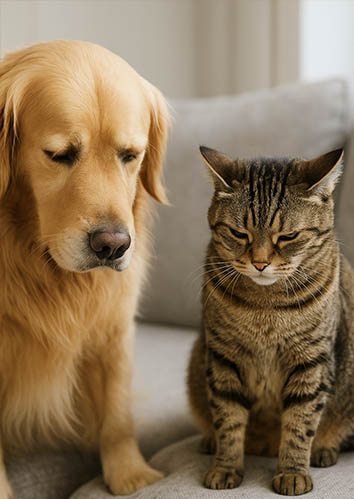
🐾 Why Recognizing Pet Pain Early Is So Important
Pets are masters at hiding discomfort. In the wild, showing pain can make an animal vulnerable, and our domesticated companions have retained this instinct. That’s why recognizing pet pain before it becomes serious is vital to their health and wellbeing.
Catching subtle signs early can prevent more significant issues down the line and ensure your pet receives timely veterinary care. Whether you have a dog, cat, or exotic pet, understanding their pain cues is part of being a responsible pet owner.
🔍 Behavioral Changes That May Signal Pain
One of the most telling signs of pain in pets is a shift in behavior. Look out for:
- Increased aggression or irritability
If your normally sweet-natured dog suddenly growls when touched or your cat swats at you, pain could be the reason. - Avoidance or hiding
Cats especially may hide under beds or in closets when they don’t feel well. Dogs may become unusually withdrawn. - Changes in routine or mobility
Limping, hesitating to climb stairs, or avoiding jumping on furniture can signal joint or muscle pain. - Loss of interest in activities
If your dog no longer wants to play or your cat isn’t exploring like usual, don’t brush it off—it may be a red flag.
🍽️ Appetite and Grooming Clues
Changes in appetite or grooming habits are another early warning sign:
- Reduced or absent appetite
Pain—especially dental pain—can make it difficult for pets to eat. - Drooling or pawing at the mouth
These are classic signs of oral discomfort, often seen in both dogs and cats. - Lack of grooming
Cats in pain may stop grooming themselves, leading to a dull or matted coat. - Overgrooming or licking one area
Pets often lick or chew painful areas excessively, which can create hot spots or sores.
🐕 Recognizing Pet Pain in Dogs
Dogs may show pain by:
- Whimpering, whining, or howling
- Shaking or trembling
- Panting excessively when not hot or excited
- Restlessness or pacing
- Stiff posture or limping
If you notice these signs, it’s time to consult a veterinarian. Read more about dog care and early intervention.
🐈 Recognizing Pet Pain in Cats
Cats are especially good at masking pain. Keep an eye out for:
- Reluctance to jump or climb
- Sudden aggression or hiding
- Decreased grooming
- Quietness or low energy
- Squinting or changes in pupil size
Explore more on cat pain management.
💡 What to Do If You Suspect Pain
If you notice any of the above signs, follow these steps:
- Document the symptoms: Keep track of what you’re seeing—when it started, how frequently it occurs, and any changes.
- Avoid giving human pain medications: Many human meds, like ibuprofen, are toxic to pets.
- Call your veterinarian: The sooner you act, the better the outcome.
- Consider a pet sitting service: If your pet is recovering from illness or surgery, a professional service like Qualified Pet Services can provide attentive care in your home.
🏥 Don’t Wait—Pain Is an Emergency in Disguise
Recognizing pet pain is a skill every pet parent should master. When in doubt, always consult your vet. Early detection not only improves your pet’s quality of life—it can save it.
Need more support? Our team at Qualified Pet Services includes professionals with veterinary backgrounds who know how to monitor pets recovering from illness or surgery. Contact us for peace of mind and compassionate care.
📌 Disclaimer
This blog is for informational purposes only and does not replace professional veterinary care. If you suspect your pet is in pain or unwell, consult your veterinarian immediately.
📚 References
- American Veterinary Medical Association. (n.d.). Pain management for dogs and cats. Retrieved from https://www.avma.org/resources-tools/pet-owners/petcare/pain-management-dogs-and-cats
- International Cat Care. (n.d.). Cat pain – physiological and behavioural signs. Retrieved from https://icatcare.org/advice/cat-pain-physiological-and-behavioural-signs/
- VCA Animal Hospitals. (n.d.). How to tell if your pet is in pain. Retrieved from https://vcahospitals.com/know-your-pet/how-to-tell-if-your-pet-is-in-pain
- ASPCA. (n.d.). Pet Care. Retrieved from https://www.aspca.org/pet-care


